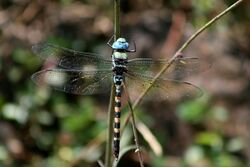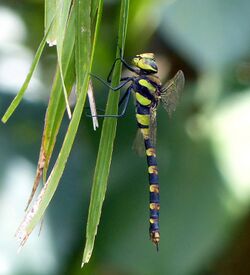Biology:Anax immaculifrons
| Magnificent emperor | |
|---|---|

| |
| Male in Tamil Nadu, India | |

| |
| Female in Kerala, India | |
| Scientific classification | |
| Domain: | Eukaryota |
| Kingdom: | Animalia |
| Phylum: | Arthropoda |
| Class: | Insecta |
| Order: | Odonata |
| Infraorder: | Anisoptera |
| Family: | Aeshnidae |
| Genus: | Anax |
| Species: | A. immaculifrons
|
| Binomial name | |
| Anax immaculifrons Rambur, 1842
| |
Anax immaculifrons,[2] the magnificent emperor,[1] or blue darner,[3] is a species of dragonfly in the family Aeshnidae. Almost all its range is in West and South Asia (the population further east in Asia is now recognized as a separate species, A. aurantiacus); it is Europe's largest dragonfly but very marginal in the continent where restricted to some Aegean Islands and Cyprus.[4][5][6]
Description
A. immaculifrons has a length of 80–86 mm (3.1–3.4 in) and a wingspan of about 120 mm (4.7 in).[5][7] It is a large, bluish green dragonfly with sapphire-blue eyes, bluish-green thorax, and pale reddish-brown abdomen marked with black. Its thorax is pale bluish-green on dorsum with a blackish-brown mid-dorsal carina and turquoise-blue laterally. There is a narrow black stripe over humeral suture and a very broad one over the postero-lateral suture with a narrow black posterior border on metepimeron. Wings are transparent with amber-yellow tint. Segment 1 of the abdomen is entirely black. Segment 2 is turquoise-blue, with a mid-dorsal transverse mark shaped like a sea-gull in flight. Segment 3 has its basal half turquoise-blue and apical half black, with a small mid-dorsal spot on blue. Segments 4 to 8 are with apical half black and pale reddish-brown at base. Segment 9 and 10 are black on dorsum.[8] A more reddish form from southeast Asia and southern China was formerly included in this species, but in 2022 it was recognized as a separate species, A. aurantiacus.[6]
Behavior
A. immaculifrons is found near slow flowing hill or mountain streams where it breeds. Eggs are inserted into reeds emerging from water.[8]
See also
- Emperor or blue emperor (Anax imperator), a relative that is widespread in Europe
- List of odonata species of India
- List of odonata of Kerala
References
- ↑ 1.0 1.1 Mitra, A. (2010). "Anax immaculifrons". IUCN Red List of Threatened Species 2010: e.T165463A6022090. doi:10.2305/IUCN.UK.2010-4.RLTS.T165463A6022090.en. https://www.iucnredlist.org/species/165463/6022090. Retrieved 20 November 2021.
- ↑ "World Odonata List". University of Puget Sound. https://www.pugetsound.edu/academics/academic-resources/slater-museum/biodiversity-resources/dragonflies/world-odonata-list2/.
- ↑ "Anax immaculifrons Rambur, 1842". India Biodiversity Portal. https://indiabiodiversity.org/species/show/226578.
- ↑ "Anax immaculifrons Rambur, 1842 – Magnificent Emperor". Dragonflies and Damselflies - in and around Europe. https://dragonflies.online/true-dragonflies-anisoptera/aeshnidae-hawkers-or-darners/anax-immaculifrons-magnificent-emperor/.
- ↑ 5.0 5.1 "Indische Königslibelle – Anax immaculifrons" (in de). libellenwissen.de. https://libellenwissen.de/artenliste/libellen-europa/indische-koenigslibelle-anax-immaculifrons/.
- ↑ 6.0 6.1 Makbun, N.; Wongkamhaeng, K.; Keetapithchayakul, T.S. (2022). "Anax aurantiacus sp. nov., a new dragonfly from mainland Southeast Asia (Odonata: Aeshnidae)". Odonatologica 51 (3-4): 301-339. doi:10.5281/odon.v51i3-4.a.
- ↑ "Magnificent emperor". Lepidoptera Libanotica. https://butterflies.spnl.org/magnificent-emperor-anax-immaculifrons/.
- ↑ 8.0 8.1 C FC Lt. Fraser (1936). The Fauna of British India, including Ceylon and Burma, Odonata Vol. III. Red Lion Court, Fleet Street, London: Taylor and Francis. pp. 145-146. https://archive.org/details/FraserOdonata3/page/n155.
External links
Wikidata ☰ Q2855285 entry
 |


